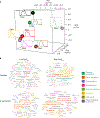Hemimetabolous genomes reveal molecular basis of termite eusociality
- PMID: 29403074
- PMCID: PMC6482461
- DOI: 10.1038/s41559-017-0459-1
Hemimetabolous genomes reveal molecular basis of termite eusociality
Abstract
Around 150 million years ago, eusocial termites evolved from within the cockroaches, 50 million years before eusocial Hymenoptera, such as bees and ants, appeared. Here, we report the 2-Gb genome of the German cockroach, Blattella germanica, and the 1.3-Gb genome of the drywood termite Cryptotermes secundus. We show evolutionary signatures of termite eusociality by comparing the genomes and transcriptomes of three termites and the cockroach against the background of 16 other eusocial and non-eusocial insects. Dramatic adaptive changes in genes underlying the production and perception of pheromones confirm the importance of chemical communication in the termites. These are accompanied by major changes in gene regulation and the molecular evolution of caste determination. Many of these results parallel molecular mechanisms of eusocial evolution in Hymenoptera. However, the specific solutions are remarkably different, thus revealing a striking case of convergence in one of the major evolutionary transitions in biological complexity.
Conflict of interest statement
Competing interests
The authors declare no competing financial interests.
Figures




References
-
- Szathmáry E & Maynard Smith J. The major evolutionary transitions. Nature 374, 227–232 (1995). - PubMed
-
- Andersson M The evolution of eusociality. Annu. Rev. Ecol. Syst 15, 165–189 (1984).
-
- Wilson EO The Insect Societies (Harvard University Press, Cambridge, 1971).
-
- Rubenstein DR & Abbot P (eds) Comparative Social Evolution (Cambridge University Press, Cambridge, 2017).
-
- Misof B et al. Phylogenomics resolves the timing and pattern of insect evolution. Science 346, 763–767 (2014). - PubMed
Publication types
MeSH terms
Grants and funding
LinkOut - more resources
Full Text Sources
Other Literature Sources
Molecular Biology Databases

